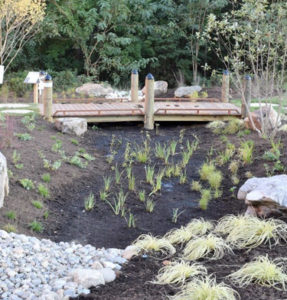Rain Gardens / Reforestation
Rain Gardens Help Stop
Polluted Runoff at the Source!
Polluted Runoff at the Source!
The Problem:
What Exactly is Stormwater Runoff?
Exactly what it sounds like! It’s when water (or snow) from storms “runs” or flows over the ground. Under natural conditions, such as a grassy meadow, this precipitation doesn’t flow very far because the ground is able to soak it up. However, problems arise in locations that have lots of hardened surfaces, like concrete, that prevent the water from being absorbed into the ground.
Our man-made system of pavement, gutters, and storm drains quickly carries stormwater runoff directly into local streams, rivers, and the Chesapeake Bay—without any natural filtering process. That means any debris, chemicals, dirt, and other pollutants in that water are flowing untreated into the waterbodies that we use for swimming, fishing, and drinking water.
Some studies show that about 50 percent of such pollution comes from individuals and homeowners through yard maintenance and chemical pollution from household activities.

 we can use to lessen the impact of stormwater, especially when it is next to the source, such as a driveway or roof, such as installing rain gardens, rain barrels, green roofs, and pervious pavers. These solutions mimic natural conditions by capturing the stormwater runoff and slowing it down so it can slowly drain into the surrounding environment instead of washing straight into our rivers. Nutrients, such as nitrogen and phosphorus, which would otherwise contribute to algae blooms and other problems in the Bay, are instead put to beneficial use by being taken up by the plants in the garden. Additionally, the absorbed water increases groundwater supply, which is important because many people get their water from underground aquifers.
we can use to lessen the impact of stormwater, especially when it is next to the source, such as a driveway or roof, such as installing rain gardens, rain barrels, green roofs, and pervious pavers. These solutions mimic natural conditions by capturing the stormwater runoff and slowing it down so it can slowly drain into the surrounding environment instead of washing straight into our rivers. Nutrients, such as nitrogen and phosphorus, which would otherwise contribute to algae blooms and other problems in the Bay, are instead put to beneficial use by being taken up by the plants in the garden. Additionally, the absorbed water increases groundwater supply, which is important because many people get their water from underground aquifers.